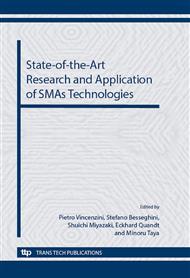p.46
p.52
p.58
p.63
p.69
p.75
p.81
p.87
p.92
Effect of Repeated Heat-Treatment under Constrained Strain on Mechanical Properties of Ti-Ni Shape Memory Alloy
Abstract:
It is well-known that the Ti-Ni shape memory alloy (SMA) is applicable to the medical stent. The repeated heat-treatment under the constrained strain is necessary for the manufacturing process of the laser-cut SMA stent. In this research, the effect of heat-treatment under the constrained strain on mechanical properties of the Ti-Ni shape memory alloy wire was investigated. The applied strain at single heat-treatment (εap) was 4, 5 and 8%, and the heat-treatment is repeated so as to became total applied strain 40%. In the case of εap=4 and 5%, partial transformation occurs in the SMA wire, and so a necking appears in the SMA wire. Due to this necking, multi-step martensitic transformation, and decreasing of breaking strength / breaking strain are caused. The necking does not occur because the whole of the SMA wire is transformed for εap=8%. The mechanical properties are improved by increasing of εap. Nevertheless, the mechanical properties of each sample are inappropriate for the medical stent. However, the mechanical properties of the as-manufactured sample are improved greatly by training. In addition, it is desirable that the applied strain during training is slightly larger than the requested strain for application.
Info:
Periodical:
Pages:
69-74
Citation:
Online since:
September 2012
Authors:
Keywords:
Price:
Сopyright:
© 2013 Trans Tech Publications Ltd. All Rights Reserved
Share:
Citation:


